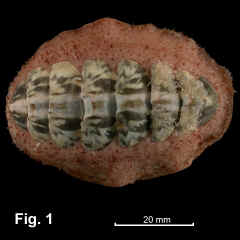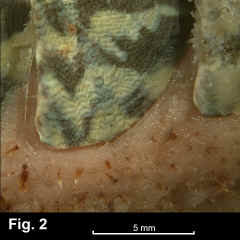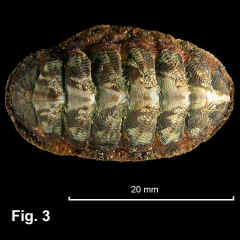|
|
MOPALIIDAE |
|
|
|
Plaxiphora albida (Blainville, 1825) Description: Animal broadly ovate, weakly angled dorsally, girdle wide, shell usually eroded or covered with marine growth. Lateral and pleural areas of valves either not separated or separated by a nodulose raised line; both areas crossed by coarse, wavy ridges. Girdle soft and spongy, with corneous prickles. Valve surface irregularly patterned with black, white and grey, sometimes splashed with green or yellow. Girdle pink. Size: Up to 87 mm in length in SA and Tas, smaller in NSW. Distribution: Endemic to Australia: Caloundra, Qld, southwards and around southern Australia, including Tas, to Perth, WA. Habitat: Lives on the upper surface of rocks exposed to surf, among Pyura and the base of macroalgae, from just above low tide level down into the subtidal zone. Remarks: The feeding of this species was studied by Kangas & Shepherd (1984) who found that it feeds on filamentous and coralline algae. Otway (1994) studied the population ecology. Individuals were estimated to live at least six years, growing rapidly for the first three years and reaching reproductive maturity at two years of age. They were found to spawn in early autumn, by discharging eggs and sperm into the sea. Fig. 1: Shelly Beach, Manly, NSW (C. 563334). Fig. 2: Detail of sculpture and girdle. Same specimen as Fig. 1. Fig. 3: Freshwater Beach, Sydney. (C.420029). Strongly sculptured specimen. (Specimen dried, girdle distorted). |
|


